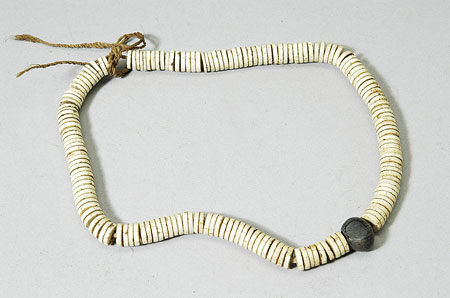Accession Number:
1940.7.072
Country:
Sudan
Region:
[Southern Sudan]
Cultural Group:
Didinga Larim [Longarim] [Narim]
Date Made:
By 1940
Materials:
Ostrich Eggshell Bird , Plant Fibre , Plant Seed , Bead
Process:
Chip Carved , Perforated , Twisted , Strung , Tied
Dimensions:
L = 215, disc bead diam = 9, th = 2, diam hole = 2; seed L = 15.4, W = 13, th = 11.5, cord diam = 1.8 mm [RTS 2/3/2005].
Weight:
56 g
Other Owners:
Samuel P. Powell
Field Collector:
Samuel P. Powell
PRM Source:
Samuel P. Powell
Acquired:
Loaned July 1940
Collected Date:
By 1940
Description:
Neck ornament consisting of a length of twisted plant fibre cord, tied in a knot at the top; this is a light brown colour (Pantone 465C).
A series of 171 white ostrich eggshell disc-shaped beads have been threaded onto this, each pierced through the centre with a medium-sized thread hole.
A single black, almost spherical seed with 2 flattened sides has been perforated and threaded in the middle of this group (Pantone black 7C).
The necklace is complete and intact, bar a few very minor chips on the edges of some beads; these are encrusted with red ochre and dirt in places.
The necklace has a weight of 56 grams, and is 215 mm long, as strung; the disc beads are all of a similar size, with a typical example having a diameter of 9 mm, a thickness of 2 mm and a thread hole diameter of 2 mm; the black seed bead is 15.4 mm long, 13 mm wide and 11.5 mm thick, while the cord itself has a diameter of 1.8 mm.
Collected by Samuel P. Powell from the 'southern border' of the Sudan and loaned to the Pitt Rivers Museum in 1940. This type of neck ornament was used by both the Didinga and 'Boya'. The latter should more properly be known as the Larim, which is what they call themselves; Boya is a name given to them by the administration and neighbouring Toposa, while the Didinga call them the Longarim. They are a non-Nilotic, pastoral group that now live in permanent mountain villages, and are part of the Didinga-Longarim-Murle language group (see the entry for 1979.20.188, and http://www.ethnologue.com/show_language.asp?code=LOH).
The ostrich eggshell beads used in this object may have been made by chipping the material to the correct size then boring a hole through it, after soaking the eggshell in water to prevent the material splitting. Several partially worked beads could then be strung together and the edges ground to finish them off. It was possible to make around one hundred beads of this kind per day (M. Carey, 1986, Beads and Beadwork of East and South Africa, p. 9).
For an almost identical ornament, see 1940.7.073. The black seeds are similar to those seen on 1940.7.049, a groin cover attributed to the Labwor.
Rachael Sparks 14/9/2005.
Collected by Samuel P. Powell from the 'southern border' of the Sudan and loaned to the Pitt Rivers Museum in 1940. This type of neck ornament was used by both the Didinga and 'Boya'. The latter should more properly be known as the Larim, which is what they call themselves; Boya is a name given to them by the administration and neighbouring Toposa, while the Didinga call them the Longarim. They are a non-Nilotic, pastoral group that now live in permanent mountain villages, and are part of the Didinga-Longarim-Murle language group (see the entry for 1979.20.188, and http://www.ethnologue.com/show_language.asp?code=LOH).
The ostrich eggshell beads used in this object may have been made by chipping the material to the correct size then boring a hole through it, after soaking the eggshell in water to prevent the material splitting. Several partially worked beads could then be strung together and the edges ground to finish them off. It was possible to make around one hundred beads of this kind per day (M. Carey, 1986, Beads and Beadwork of East and South Africa, p. 9).
For an almost identical ornament, see 1940.7.073. The black seeds are similar to those seen on 1940.7.049, a groin cover attributed to the Labwor.
Rachael Sparks 14/9/2005.
Primary Documentation:
Accession Book Entry
[Loans II, p.
308] - ESTATE OF S.P.
POWELL, C/O N.H.
HASLAM, Esq.
Manager, Westminster Bank, Stony Stratford, Bucks.
Collected by himself.
Data from his labels and notes.
[p.
312] From the DIDIGNA (DODINGA) tribe, ANGLO-EGYPTIAN SUDAN (southern border).
1940.7.072-.073 - [1 of] 2 necklaces of ostrich-egg-shell discs (DIDINGA and BOYA).
Card Catalogue Entry - A.E. SUDAN, SOUTHERN BORDER, DIDINGA (DODINGA) TRIBE (also BOYA). 1940.7.072-073. Two necklaces of ostrich eggshell beads (discs). S.P. Powell col. Lent by his executors [RTS 12/2/2004].
Pitt Rivers Museum label - Necklace made of ostrich-eggshell discs. BOYA & DIDINGA (Nilotic tribes). Anglo-Egyptian Sudan. S.P. Powell [brown luggage label, tied to object; RTS 2/3/2005].
Related Documents File - Appears on undated typed list: [insert] 1940.7.072-073 [end insert] - "2 Didinga or Boya necklaces made from ostrich egg shell". List is annotated by hand on back: "List of Curios" and "Far from complete" [RTS 16/12/2003].
Card Catalogue Entry - A.E. SUDAN, SOUTHERN BORDER, DIDINGA (DODINGA) TRIBE (also BOYA). 1940.7.072-073. Two necklaces of ostrich eggshell beads (discs). S.P. Powell col. Lent by his executors [RTS 12/2/2004].
Pitt Rivers Museum label - Necklace made of ostrich-eggshell discs. BOYA & DIDINGA (Nilotic tribes). Anglo-Egyptian Sudan. S.P. Powell [brown luggage label, tied to object; RTS 2/3/2005].
Related Documents File - Appears on undated typed list: [insert] 1940.7.072-073 [end insert] - "2 Didinga or Boya necklaces made from ostrich egg shell". List is annotated by hand on back: "List of Curios" and "Far from complete" [RTS 16/12/2003].



